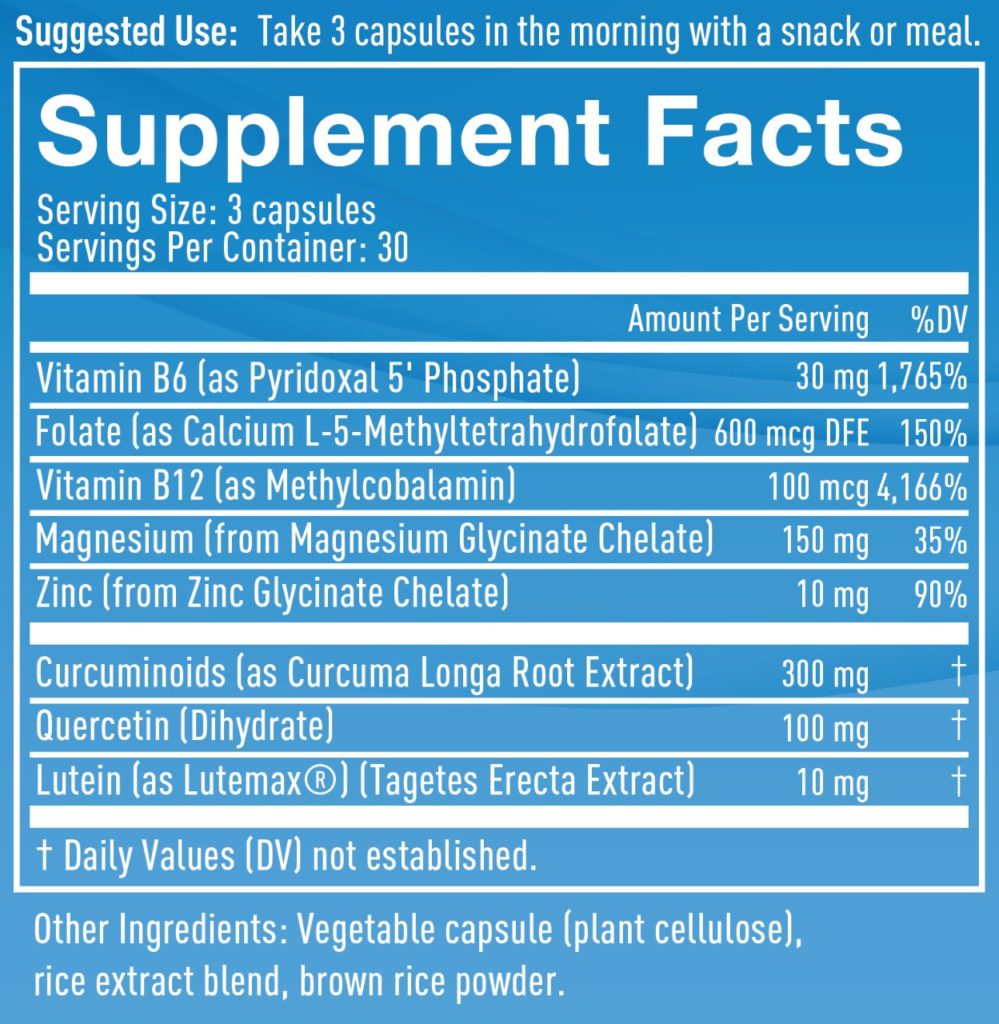SCIENCE
HOW AIR+GUARD® INGREDIENTS HELP SUPPORT YOUR HEALTH
There is a limit for each body’s defense systems that is based on multiple genetic and lifestyle factors. Air+Guard is designed to support these defense systems in people who have been exposed to environmental toxins and airborne pollutants. Air+Guard powerfully supports the metabolizing, neutralizing and excreting of airborne toxins through the body’s Phase I, II, and III detoxifying systems*. The following are brief descriptions of the active ingredients of Air+Guard, along with a sample of over 100 supporting research studies identified by the BRILLIANT Team during the product development process.

Vitamin B6 (as Pyridoxal 5’ Phosphate)
Folate (as Calcium L-5-Methyltetrahydrofolate)
Vitamin B12 (as Methylcobalamin)
These ingredients work to:
- Support methylation detox pathway*
- Support Phase I and II detox processes to transform toxins for excretion*
- Support synthesis of DNA, RNA and proper cell division*
- Support energy production*
- Support hemoglobin formation (for blood oxygen-carrying)*
- Support healthy immune response*
- Support neurological function*
- Bioavailable to people with MTHFR variants*
Epifolin®, our patent pending blend of methylated B vitamins, supports the body in making and repairing DNA, RNA and chromatin and preserving the one carbon-based methylation cycle in the presence of chemicals that will potentially interfere*. By keeping methylation going, the entire body benefits, but in specific, these ingredients keep the methylation detox cycle operating*. The methylation detox cycle is a primary player in handling air pollution that gets into the lung tissues and bloodstream and ends up being detoxified by the liver in Phase I and II. This process is critical and not typically addressed because most “detox” supplements and protocols just focus on antioxidants.
Magnesium (from Magnesium Glycinate Chelate)
Zinc (from Zinc Glycinate Chelate)
These ingredients work to:
- Support Antioxidant Defense System*
- Support normal removal of heavy metals*
- Support cellular detox*
- Support Phase I, II, and III detox processes to transform and excrete toxins*
- Support healthy DNA synthesis and cell division*
- Support healthy immune response*
- Support energy production*
- Support healthy reproductive function, spermatogenesis, fertility, pregnancy*
The chelated minerals in Air+Guard® contribute to dozens of enzymatic reactions that are critical to life*. Specific to air pollution, these minerals support DNA methylation and are required in Phase I and II liver detoxifying of the small particles that pass into the blood stream*.
Curcuminoids (as Curcuma Longa Root Extract)
Quercetin (Dihydrate)
Lutein (as Lutemax®) (Tagetes Erecta Extract)
These ingredients work to:
- Support the Antioxidant Defense System*
- Scavenge free radicals, reactive nitrogen species (RNS), reactive oxygen species (ROS)*
- Support natural anti-inflammatory responses*
- Support healthy lungs, brain, and mucous membranes*
- Support Phase II antioxidant enzymes for detox*
- Support methylation detox pathway*
- Support healthy eye function by maintaining macular and retinal health*
- Support healthy immune response*
To maintain health, the body must detoxify the free radicals, reactive nitrogen species (RNS) and reactive oxygen species (ROS) that come from air pollution, diet, smoking, alcohol, drugs, inflammatory by-products, and metabolic byproducts such as hormones. The antioxidants in AIR+GUARD® support Phase II detoxifying of these compounds by the liver*. The antioxidants also support transporting the toxins out of the body by the gut and kidneys in Phase III detoxifying*. Air+Guard® includes a variety of antioxidants because they each have unique attributes that contribute to cleaning up the ROS, RNS and free radicals*.

SOURCES AND TYPES OF AIR POLLUTION
Air Pollution generally consists of gases and particulate matter (PM). These pollutants may be absorbed by cells in the lungs, skin, mucous membranes, and intestines, then transported into the bloodstream where they travel around the body. The size of non-gaseous PM is typically indicated by number, including PM10, PM2.5. and PM0.1 (Ultrafine Particles or UFPs). The smaller the particle size, the more easily it is absorbed and the more potential it has to cause harm if the body cannot effectively detoxify and excrete it.
Here are some examples of common hazardous air pollutants (HAPs):
Unlike many organic pollutants which will eventually degrade over time, heavy metals cannot be broken down. When they accumulate in the body, heavy metals can interfere with multiple biochemical processes, inhibiting growth and development, blocking oxygen absorption by cells and interfering with tissue repair and reproduction. Some sources of heavy metals in the air include emissions from incineration of electronic components, industrial materials and processes, and machines and vehicles.
Although ozone in the upper atmosphere serves to protect us, the ozone occurring at ground level can be unhealthy at high levels. It is created when sunlight interacts with other air pollutants, especially nitrogen oxides (NOx) and volatile organic compounds (VOCs). Ozone is a special concern during the summer months of sunshine and in urban and suburban areas with traffic and industry. But ozone can also be a problem for rural areas because winds can carry emissions hundreds of miles from their original sources. Ozone pollution can trigger acute symptoms like coughing, chest pain and throat irritation. By causing inflammation of the lungs and reducing lung function, ozone can make bronchitis, emphysema and asthma worse and may eventually scar the lungs.
Carbon monoxide (CO) is a colorless, odorless gas. When it is inhaled it displaces oxygen in the blood resulting in oxygen deprivation for cells in the brain, heart, and other vital organs. Exposure to significant CO can cause loss of consciousness and suffocation within minutes. Breathing smaller amounts of inhaled CO over longer periods of time is correlated to adverse health effects in people at risk. CO pollution results from incomplete combustion of fuel such as oil, coal, wood and gas. It is especially dangerous indoors where it can accumulate from fireplaces, gas stoves, lanterns, and furnaces.
Measurements of black smoke in the air are closely correlated with PM10. High levels are frequent during wildfires, where incompletely burned wood releases carbon particles. Sulphur dioxide (S02), the most abundant of polluting sulfur compounds, primarily results from the combustion of fossil fuels at power plants and from other industrial smokestack emissions. Diesel engines are also a major source of unburned hydrocarbons, carbon monoxide, nitrous oxide (NOx), sulfur oxides, PM, and Black Smoke. Exposure to all of these pollutants correlates to increased inflammation and cytotoxicity and decreased immune system and organ functioning.
VOCs are chemically unstable and vaporize quickly into the atmosphere, causing air pollution. Long term exposure is associated with many negative health effects. Examples of volatile organic compounds including methane, cleaning solvents, and pesticides as well as gasoline engine emissions including ethanol, benzene, toluene, and xylene. VOCs are generally treated as two categories: indoor and outdoor. Concentrations are often higher and more dangerous indoors and are often released by household cleaners, paint, flooring/carpets, furniture, and cigarettes.
IMPACTS OF AIR POLLUTION ON HUMAN HEALTH
There are now over 70,000 research papers showing that air pollution is negatively affecting human health across our lifespan. Air pollutants are linked to potential harm to the brain, nervous system, lungs, liver, kidneys, heart, eyes, skin and mucous membranes, female and male reproductive systems, DNA, RNA, chromatin, and the immune system. Pregnant mothers and children, with their immature organs, immature immune systems, and special requirements for growth and development, are particularly vulnerable to negative effects of air pollution. The following are some brief summaries of the ways that air pollutants can impact your health:

Exposure to air pollution has been shown to negatively impact telomere length, innate immunity, and cause epigenetic modifications. These effects, along with inflammation and systemic toxicity may contribute to premature aging and mortality.
Acute localized inflammation, including heat, pain, swelling, redness and loss of function in body tissues are immediate responses to cellular injury. When the body is unable to resolve acute inflammation and it continues over a long period of time, it is called chronic inflammation. Chronic inflammation and chronic systemic (non-local) inflammation can result from long term exposure to air pollutants.
Cytotoxicity is the ability of certain chemicals or mediator cells to cause cell injury or death. Long-term exposure to non-lethal dosages of cytotoxic air pollutants may lead to the accumulation of DNA lesions which are sites of damage of the base pairing or structure of the DNA. Pollutants can cause double strand breaks in the DNA and can also stall replication forks due to damaged DNA. The accurate, timely replication of DNA is necessary for growth, repair, and healthy functioning of cells and tissues. Damage to the DNA caused by cytotoxicity may be one of the mechanisms responsible for adverse health effects of particulate air pollution.
One carbon metabolism and methylation are interrelated biochemical processes required for maintaining health, including synthesizing RNA, DNA and neurotransmitters, immune cell differentiation, histamine and hormone clearance, central nervous system development in utero and in growing children, and gene expression. One carbon metabolism is affected by nutritional intake and in turn can affect methylation. Diminished methylation can inhibit detoxification from air pollution as well as lead to a wide range of other health problems.
Emerging data from research reveals that air pollution modifies epigenetic markings and impacts DNA methylation (DNAm). The resulting changes may influence inflammation, development of disease, and possible increase in severity of the disease. Epigenetic markings are changes to DNA packaging components that turn gene transcription on and off and that are heritable by “daughter” cells.
Both innate and adaptive immune systems are sensitive to air pollution. Researchers have linked exposure to these toxins to asthma, allergic reactions, endocrine disorders, autoimmune diseases, cardiovascular disease and cancer.
The lungs are a primary route of air pollution into the body with the potential for resulting in chronic inflammation and tissue damage, reduced lung capacity and function, reduced oxygen saturation, flare ups of allergies, asthma, progression of emphysema and COPD.
Chronic inflammation caused by air pollution contributes to the progression of cardiovascular diseases including ischemia, stroke, hypertension, arrhythmias, and morbidity.
The liver is particularly vulnerable to the effects of air pollution because of its role in cleaning the blood. Exposure to particulate matter has been shown to cause liver fibrosis and lower the survival rate of patients diagnosed with liver cancer.
Besides the lungs, the skin receives the immediate negative impact of air pollution. Contact with pollutants correlates with skin aging and higher rates of inflammatory and allergic conditions including atopic dermatitis, eczema, psoriasis, acne, and skin cancers.
Systemic inflammation resulting from chronic exposure to air pollution has been shown to negatively affect retinal blood flow with long term changes in the microcirculation of the eye. There is also an association between air pollution and diabetic retinopathy in diabetics.
Exposure to air pollutants can negatively affect both small and large blood vessels, causing circulation and structural changes to brain tissue. These changes, in turn, may negatively affect neuroplasticity and memory and are associated with decreased functioning and progressive degenerative diseases of the brain and central nervous system. Air pollution-induced neuroinflammation, oxidative stress, microglial activation, cerebrovascular dysfunction, and alteration in the blood-brain barrier contribute to central nervous system disorders. In addition, exposure to air pollutants that are endocrine disrupting can negatively affect hormones and contribute to ADHD and autism.
Air pollutants that chemically disrupt the endocrine system and impact hormones have wide reaching consequences. In particular, endocrine disrupters negatively influence pre and postnatal development, male and female reproductive systems. Epidemiological studies point to the negative effects of endocrine disruptors on neurodisorders (ADHD, autism), neurodegenerative disorders (MS, Parkinson’s, Alzheimer’s), Type 2 diabetes and metabolic syndrome, cardiovascular and lung disease, and certain cancers.
Air pollutants have been associated with polycystic ovarian syndrome, premature ovarian failure, uterine fibroids, aneuploidy, endometriosis, breast cancer, precocious puberty, and reproductive tract anomalies. Associations have also been found with increased rate of miscarriage, reduced numbers of oocytes, and in women using in vitro (IVF) procedures, there was a reduced conception and live birth rate.
Endocrine disrupting air pollutants have been associated with hypospadias, cryptorchidism, distortion of semen quality, and prostate cancer.
In addition to the impacts on Female Fertility, exposure to air pollutants is associated with increased miscarriage, low birth weight, and premature birth.
Exposure of the pregnant mother to PM air pollutants is associated with impaired childhood lung function, increased incidence of childhood asthma, lower birth weights, neural tube defects, and reduced length of telomeres across lifetime.
Exposure to air pollutants by children is associated with impaired brain architecture and development, ADHD and autism, negative impact on respiratory function with increased frequency of postnatal mortality and sudden infant death syndrome (SIDS), increased frequency of asthma and severity of asthma symptoms and suppression of the immature immune system.



